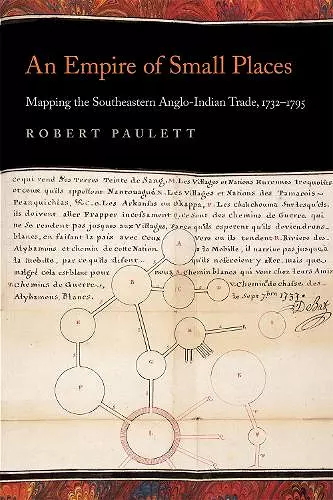An Empire of Small Places
Mapping the Southeastern Anglo-Indian Trade, 1732–1795
Format:Paperback
Publisher:University of Georgia Press
Published:1st Sep '12
Currently unavailable, and unfortunately no date known when it will be back

Britain’s colonial empire in southeastern North America relied on the cultivation and maintenance of economic and political ties with the numerous powerful Indian confederacies of the region. Those ties in turn relied on British traders adapting to Indian ideas of landscape and power. In An Empire of Small Places, Robert Paulett examines this interaction over the course of the eighteenth century, drawing attention to the ways that conceptions of space competed, overlapped, and changed. He encourages us to understand the early American South as a landscape made by interactions among American Indians, European Americans, and enslaved African American laborers.
Focusing especially on the Anglo-Creek-Chickasaw route that ran from the coast through Augusta to present-day Mississippi and Tennessee, Paulett finds that the deerskin trade produced a sense of spatial and human relationships that did not easily fit into Britain’s imperial ideas and thus forced the British to consciously articulate what made for a proper realm. He develops this argument in chapters about five specific kinds of places: the imagined spaces of British maps and the lived spaces of the Savannah River, the town of Augusta, traders’ paths, and trading houses. In each case, the trade’s practical demands privileged Indian, African, and nonelite European attitudes toward place. After the Revolution, the new United States created a different model for the Southeast that sought to establish a new system of Indian-white relationships oriented around individual neighborhoods.
This is an important and insightful analysis of the development of colonial Augusta, the Indian trade, and the geography of the Southeast. Paulett convincingly demonstrates how the region was transformed geographically from a world where Natives and newcomers understood that they were interconnected by a series of paths to one where they believed they lived in discrete neighborhoods. This ideological and physical transformation has tremendous explanatory value and will be of interest to historians of the early South, Native Americans, urban America, and the frontier in general.
* author of Creeks and Southerners: Biculturalism on the Early American Frontier *In this interesting and engaging book, Paulett contributes to important conversations about eighteenth-century colonialism and Indian- European relations.
* author of Okfuskee: A Creek Indian Town in Colonial America *[Robert Paulett] encourages us to understand the early American South as a landscape made by interactions among American Indians, European Americans, and enslaved African American laborers.
* McCormick Messenger *Robert Paulett has given us a refreshing consideration of life in the eighteenth-century deerskin trade. His focus on disparate groups occupying the same arena but living different experiences challenges us to reimagine the complexities of life among multiple cultures and changing landscapes. . . . [H]is work adds new information and a different perspective to studies of the American South.
* Southern Spaces *The blend of geography, history, and social observation makes for a fine survey examining Britain’s colonial empire in North America and its economic and political ties with various Indian nations.
Any scholar of the colonial South, particularly those interested in Indians and slavery, will want to add this title to her or his bookshelf.
* South Carolina Historical MagaziISBN: 9780820343471
Dimensions: 229mm x 152mm x 16mm
Weight: 431g
264 pages